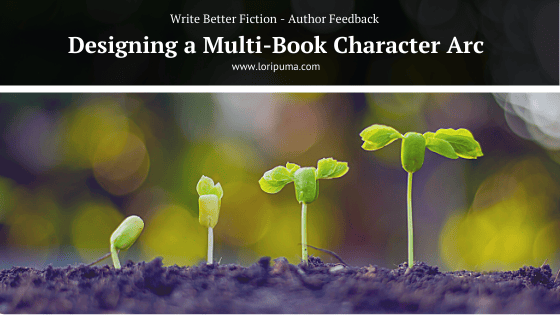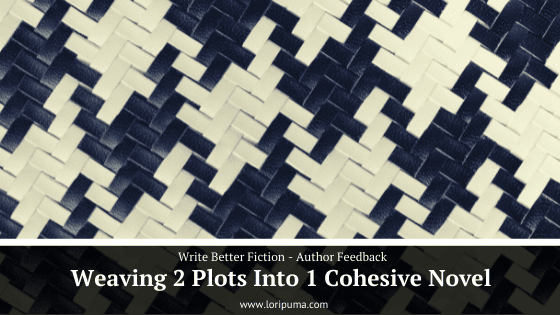Designing a Multi-Book Character Arc
/Are you working on a multi-book series, but not sure how to create the overall narrative? See how to plan a character arc that lasts an entire series and decide what belongs in Book 1.
Today’s author is Amber. She describes her novel as a historical adventure romance. Here’s her summary:
Chloe Darting is a student at Greenway Academy, currently an all male (she’s the only female) military training academy that specializes in more targeted training for political spies, assassins, extreme tracking skills etc. set roughly in the late 1500s-1600, right on the cusp of weaponry shifting towards gunpowder and the like.
Before we go further let me call out one genre assumption I’m making from Amber’s submission.
I think the romance covers multiple books, which means the romance is almost certainly a subplot. That means the novel is going to follow a thriller/action plot structure as opposed to a romance plot. (See this post for more on the different plot types.)
In terms of what she’d like feedback about, Amber shared that she’s been working on the story for 16 years and says:
To get any feedback and an overall view of where I’m trying to go and smooth out some plot holes would be amazing.
Since I’ve been writing this for so long, I literally have stuff from when she’s 14 up until she’s 20ish and married. I had planned for 6 books originally, but it’s just a hot mess figuring out where to start and stop for book one now. Overarching plot: training, getting assigned to targets and missions, building relationships while slowly unraveling the bigger political pieces that will end in war.
Clearly, this story means something to Amber, since she’s been working on it for so long! It can be tough to see the big picture when you’ve been working on the details of a story for many years.
Where to start when you’re not sure of the overall story
Whether you’re unsure of the plot for a single book, or feeling overwhelmed when you think about a multi-book series, one thing that can help you focus is getting very specific about what matters to you in the story.
There are lots of reasons for writing a novel. You might want to make readers laugh, or mess with their minds with plot twists, or convey a positive message, or be true to a particular character. Whatever is most important to YOU should be the biggest influence on what shows up on the page.
Here’s what Amber says is most important to her:
Probably the overall character growth and change from having no choice of attending the academy, to needing to prove something to people, to ultimately being confident and solid in herself. With all the crazy going on in missions, adventure etc, seeing how much people change and how human everyone is, no matter the era or job or lifestyle, is my favorite. Rich characters are my favorite.
We know that Amber’s story will prioritize character growth over everything else. So what does it take to create a character arc for a series?
Designing a character arc for a multi-book series
When you’ve got a series with a protagonist who grows over multiple books, it’s a good idea to break down that character’s growth into smaller pieces so you can pace the character’s changes evenly. You want to create a noticeable difference in the protagonist from beginning to end of each book that adds up to an even larger difference from beginning to end of the series.
If you know where you’d like the character growth to end, then the best place to begin is usually at the opposite end of the spectrum. That gives you the most range with which to explore your character’s inner world. If you want your protagonist to end the series feeling confident in herself and her abilities, then the series should probably begin showing her experiencing self-doubt.
Each book in a series with a self-confidence character arc would show a different type of challenge to that confidence. One book might be about learning the difference between taking responsibility for your own actions and not blaming yourself for circumstances beyond your control. Another might be about going from doing everything on your own to finally trusting others. Another could be about recovering from the betrayal of someone you trust. In each book, there’s one big lesson for the character to learn.
Since the best way to show character growth is by showing how your protagonist responds to stress, the narrative arc of each individual book serves dual purposes. It helps the protagonist learn the lesson about confidence AND it shows the protagonist working toward their objective Story Goal (e.g. defeating a villain, saving a friend, winning a competition).
How close are you to crafting a novel readers won’t be able to put down? Take a quiz to see what’s working and what comes next.
One lesson the protagonist could learn
Talking about character arcs can feel vague. So let’s walk through a specific example of a lesson Amber’s protagonist could learn and then see how that lesson can turn into a plot for Book 1.
For the rest of this blog post, let’s assume that the lesson Chloe learns in Book 1 is a transition from “I can learn everything I need to survive without the academy” to “I need to stay at the academy”. That’s a distinct shift readers will recognize as a change. It’s also a change that’s small enough that Chloe has room for additional growth over future books in the series.
There are infinite possibilities for what the character arc could be. But turning a general idea into two contrasting statements can help make the arc more concrete in your mind so you know what your plot needs to do.
(And if thinking about abstract beliefs isn’t how you think about characters, check out the Next Steps section for an alternate method of figuring out your character arc.)
How to turn a lesson into a plot
Once you know what the lesson is, how do you turn it into a page-turning plot?
The basic idea is to show your character repeatedly responding to events that challenge their existing beliefs, and what’s possible if they adopt a new belief.
If Chloe starts the arc believing, “I don’t need the academy,” she has to have reasons. For example, maybe she’s running with a crew of street kids already. She thinks she can learn everything she needs about survival from hanging out with them. (There could be many other reasons. I’m just picking one specific one again for the sake of example.)
If that’s the case, then throughout Book 1, we want to see Chloe repeatedly choosing her crew over the academy. Except that it’s increasingly painful to make that choice.
For example
She might help the crew steal food, but one of the crew gets caught and Chloe might feel guilty when the crew member gets pilloried.
She might help the crew raise money by betting on pub brawls. Which is fun until her friend who’s fighting gets seriously hurt and the other crew members leave him to fend for himself.
She might do a job eavesdropping on someone in the village and then the person paying her to do the eavesdropping might refuse to pay her, or even worse. Might steal the money she was counting on to buy a winter cloak or other needed supplies.
Similarly, Chloe needs reasons to adopt a new belief. Throughout Book 1, she needs to experience tangible benefits of the academy. These can be positive benefits. Or lesser evils. And over the course of the book, the benefits of the new belief will outweigh the cost of changing.
Positive benefits might be
A friend can distract a group of bullies, so Chloe has to time to run to safety
A student or instructor can tutor Chloe on work that’s difficult for her but important for her survival
Instructors or administrators can save Chloe from harsher punishment than what she’d receive if she’s prosecuted as a street kid.
A team of students on a mission can help Chloe get to safety when she’s injured instead of leaving her behind, even if they’re punished for not completing their mission.
Lesser evils could be
The academy hears about planned raids before they happen, meaning Chloe can warn her friends before they get hurt.
On the streets, young people are being conscripted to work as slaves. But academy students are protected from that fate since they’re learning to serve the kingdom in a different way.
When you consider the chief antagonist for the story, think about what kind of character (or group of characters) is going to have the most impact on making Chloe want to stay at the academy (or making her learn whatever other lesson you choose).
Because this book uses an action plot, the climax of the story will be a showdown between Chloe and the chief antagonist. So you can also consider what kind of antagonist Chloe can overpower or outwit in a way that will show her mastery of this book’s lesson, yet also create bigger problems for her in the next book.
To recap, the main threads to weave together for the plot of Book 1.
Experiences showing the pain caused by sticking with the old belief
Experiences showing the possibilities opened up by adopting a new belief
A chief antagonist who spurs Chloe to change by creating problems for her (and her allies), and who’s also connected to the larger forces shaping the world
Will your fantasy novel leave readers hungry for more of your writing? Take the quiz to see what’s working and what comes next.
Next steps for Amber
My recommendation to Amber is to figure out what lesson Chloe needs to learn in Book 1, identify the character who has the best chance of inspiring Chloe to learn that lesson, and brainstorm the life experiences that will persuade Chloe she needs to change.
FIGURING OUT THE LESSON
What is the 1-sentence statement that describes what Chloe believes at the beginning of Book 1? What does she believe at the end? What are the belief statements for the other books in the series?
If it’s easier to think about characters in scenes, try this as an alternate method for figuring out the character arc. Brainstorm 10 pairs of opening and closing scenes that show readers what’s different. For each pair, describe the lesson learned/change made.
For example
Opening — Chloe and the street kids collect protection money from local farmers on behalf of a crime boss.
Closing — Chloe and her fellow academy students surround the crime boss, steal his money and distribute the funds back to local farmers.
Lesson learned/change made — Chloe stops believing stealing is ok and starts protecting people from thieves.
THE ONE CHARACTER WHO MOST INSPIRES CHANGE IN THE PROTAGONIST
Once you know what lesson you want Chloe to learn, can you find one character who will give Chloe the strongest reasons to change? This character will be your chief antagonist. What plans can the chief antagonist set in motion that will force Chloe to experience the pain of her old beliefs? Alternatively, you can figure out the experiences first, and then consider—who could be responsible for creating many of these painful moments?
SCENES SHOWING THE NEED FOR CHANGE
Create a list of the two types of life experiences will persuade Chloe to change in Book 1
Brainstorm negative experiences that show her the trouble she faces if she sticks with her original belief. Her starting belief must offer her some kind of protection. How can you strip that protection away from her?
Brainstorm positive experiences that show her the advantages of adopting the ending belief. Will she gain safety? Friendship? Access to materials? Access to people? Can get herself out of trouble with the law? Will she be able to intervene more successfully when friends are in trouble with the law? How can you give her experiences that will show her the tangible benefits of thinking and acting differently?
A character’s life experiences are always the best trigger for believable character growth. Building a plot that uses those life experiences to teach your protagonist one specific lesson can help you find an overall narrative arc that’s always challenging for your character and satisfying to your readers.
Enjoy this post? Join my email list so you’ll know when I publish the next author feedback post.
Or maybe you’ve got a fantasy, sci-fi, romance, mystery, or thriller for adult or young adult readers that you want feedback on? Submit your story.









